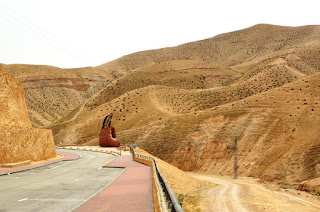Pass the salt!
In this blog we will go from the beginning of the Dead Sea to the end.
Just before arriving at the Dead Sea from Jerusalem, you pass by Jericho.

Right after the highway turns south coming from Jerusalem passed Jericho is Qumran. From 150 BC to AD 68 this site was home to an ascetic community of Essenes. They passed from existence following the conflict with the Romans. In 1947 a Bedouin shepherd boy came across a cave of jars filled with scrolls while looking for a lost goat. Those jars contained 190 linen-wrapped scrolls dating back 2,000 years. Over the next twenty years scrolls were found in a total of 11 caves.
Copies of the scrolls found here are housed in the Shrine of the Book attached to the Israel Museum in Jerusalem. Extensive ruins are accessible. But the highlight for me was to walk to the edge of the ruins of the Essene community and see the cave in the adjoining ridge where the scrolls were found! These scrolls contain the oldest known versions of various books of the Bible including a copy of the book of Isaiah dating to 100 B. C. It is a wonderful story of how the Bible was preserved and protected through the generations.
At the extreme other end of the Dead Sea in a truly arid and barren area is the traditional site of Sodom.
We were surprised to find a sign indicating where Lot's wife was turned to a pillar of salt. There on top of one of the mountains made of salt was a formation that looks like part of it is leaning away from the rest--Lot's wife!
Just below the outcropping called Lot's wife is a cave.
Just before arriving at the Dead Sea from Jerusalem, you pass by Jericho.
 |
| Here is the Zacchaeus sycamore tree! |
 |
| Here is a view from the Old City of Jericho towards the Mount of Temptation, where Jesus was tempted for forty days and nights. |

To reach the Mount of Temptation you have to travel via cable car over a mile north of the Old City. Carved out of the mountain is the Monastery of the Temptation dating back to the 12th century.
Here is one of the pathways in the monastery. You can see the row of rooms used by the monks who live there.
Jericho sits as an oasis in a vast arid area.
Right after the highway turns south coming from Jerusalem passed Jericho is Qumran. From 150 BC to AD 68 this site was home to an ascetic community of Essenes. They passed from existence following the conflict with the Romans. In 1947 a Bedouin shepherd boy came across a cave of jars filled with scrolls while looking for a lost goat. Those jars contained 190 linen-wrapped scrolls dating back 2,000 years. Over the next twenty years scrolls were found in a total of 11 caves.
Copies of the scrolls found here are housed in the Shrine of the Book attached to the Israel Museum in Jerusalem. Extensive ruins are accessible. But the highlight for me was to walk to the edge of the ruins of the Essene community and see the cave in the adjoining ridge where the scrolls were found! These scrolls contain the oldest known versions of various books of the Bible including a copy of the book of Isaiah dating to 100 B. C. It is a wonderful story of how the Bible was preserved and protected through the generations.
At the extreme other end of the Dead Sea in a truly arid and barren area is the traditional site of Sodom.
We were surprised to find a sign indicating where Lot's wife was turned to a pillar of salt. There on top of one of the mountains made of salt was a formation that looks like part of it is leaning away from the rest--Lot's wife!
Just below the outcropping called Lot's wife is a cave.
The rock formation really is composed of a salt-like substance.
The Dead Sea area truly is beautiful. Hard to imagine that in all that beauty it is a mineral-laden dead sea!



















0 Comments:
Post a Comment
<< Home